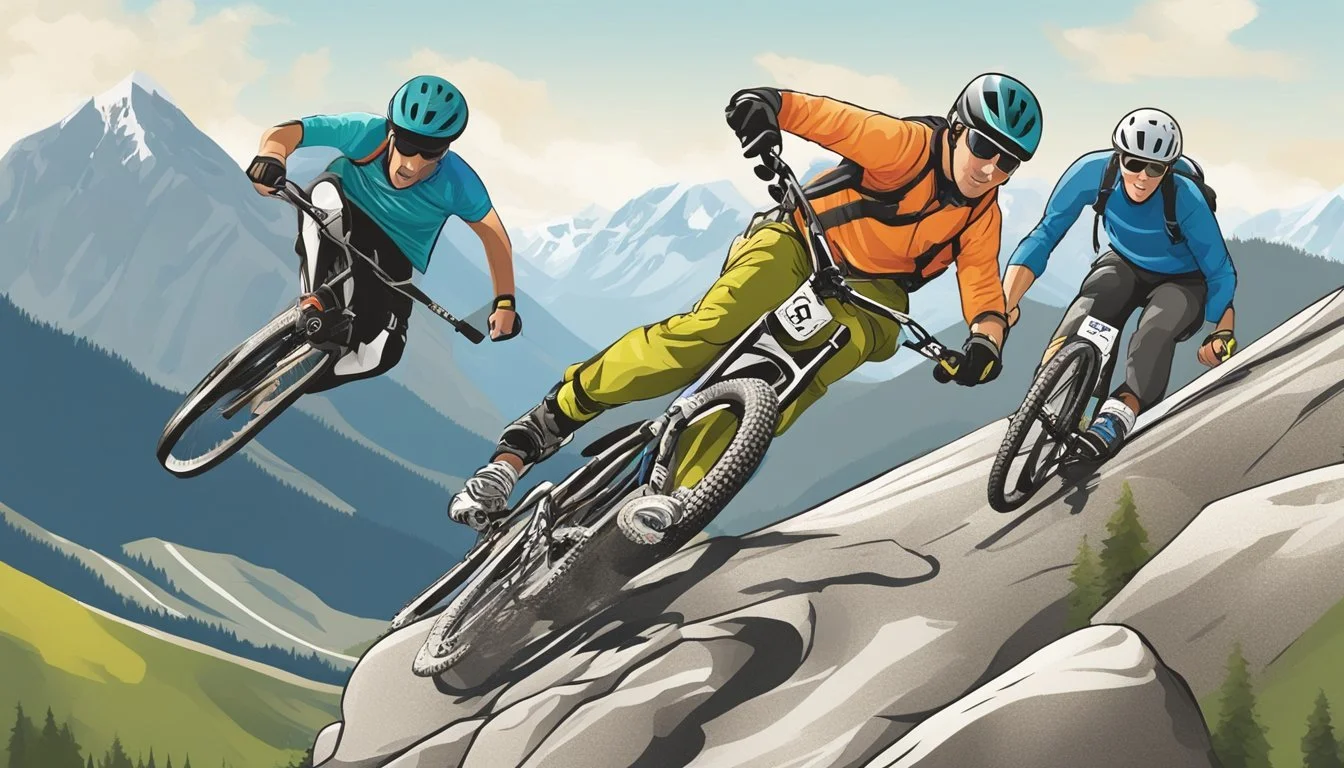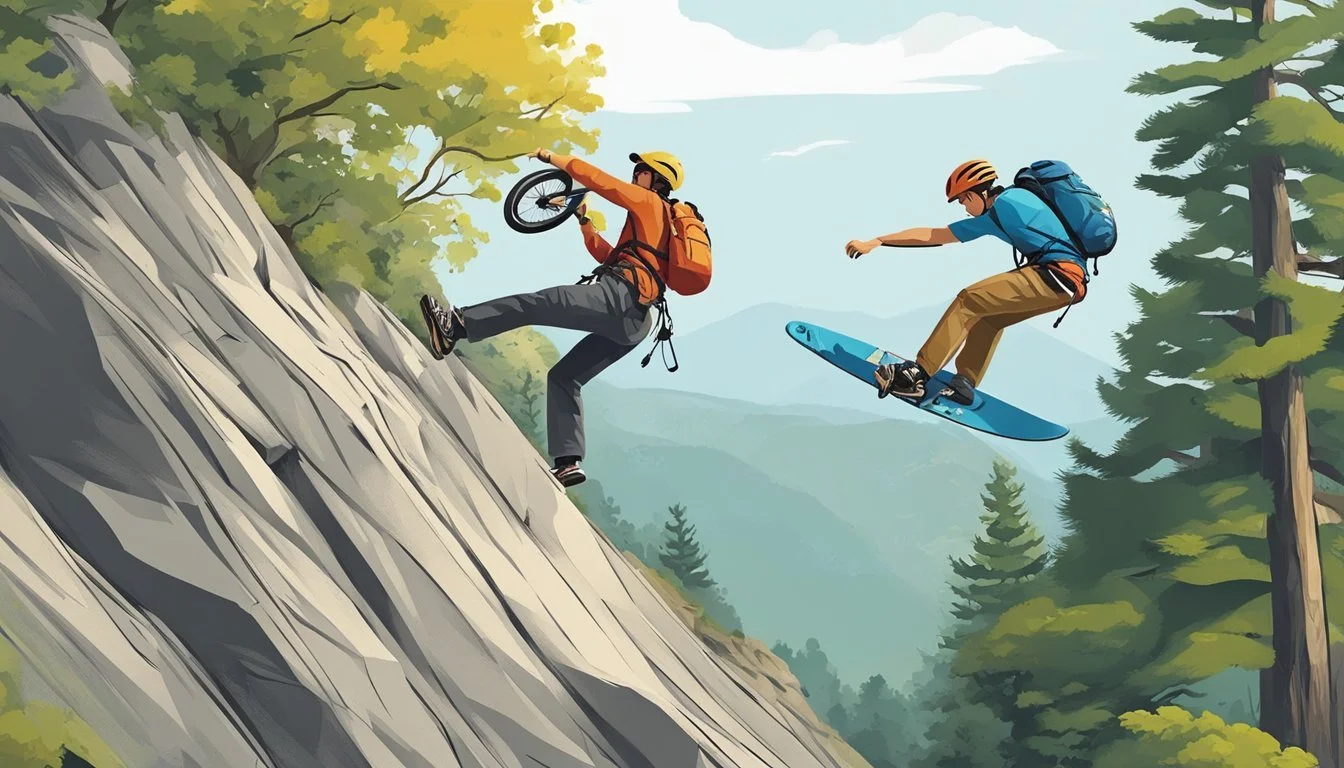4 Types of Trauma That Can Occur in Adventure Sports
A Brief Overview
Adventure sports present an exhilarating way to challenge one’s physical limits and experience the great outdoors. Understanding the types of trauma associated with these sports is crucial for participants aiming to stay safe and injury-free. Whether engaging in mountain biking, hiking, or other high-risk activities, being informed about potential injuries can make a significant difference in preparation and response.
This article explores the various kinds of trauma that can occur in adventure sports. This information is vital for athletes, enthusiasts, and medical professionals who want to minimize risks and ensure that adventurers can enjoy their activities with confidence and peace of mind.
1) Fractures
Fractures are common in adventure sports due to high-impact activities and unpredictable environments. These injuries occur when a bone cracks or breaks entirely and can range from minor hairline fractures to severe compound fractures.
In sports like mountain biking or rock climbing, falls are frequent, leading to various types of fractures.
A skier's fall can cause fractures to many bones including the tibia or fibula. Snowboarding accidents often result in wrist fractures due to the natural reflex to break falls with extended arms.
Fractures not only cause pain but also severely limit mobility, making immediate medical attention crucial. Proper stabilization and quick transport to medical facilities can prevent further complications.
For more information on different types of fractures and their treatment, refer to Types Of Fractures - Types, Causes and Treatment - Sports Injuries.
Understanding the risks and symptoms helps participants take preventive measures and seek prompt treatment when injuries occur.
2) Concussions
Concussions are mild traumatic brain injuries often resulting from a bump, blow, or jolt to the head. These injuries can occur in various adventure sports, such as mountain biking, skiing, or rock climbing.
Symptoms of a concussion can include headache, confusion, dizziness, and sometimes temporary loss of consciousness. It's crucial to differentiate between a concussion and more severe head injuries.
Proper diagnosis by a medical professional is essential. Repeated concussions can lead to long-term consequences, emphasizing the importance of prevention and careful management. More information on sports-related concussions can be found at The Merck Manuals.
Athletes who suffer a concussion should rest and avoid activities that could risk another head injury until fully recovered. Quick and proper treatment is fundamental for a safe return to sports.
Education and awareness are key in preventing and managing concussions. Coaches, trainers, and athletes must recognize the signs and seek appropriate care promptly. Ensuring safety gear is used correctly can also reduce the risk of concussions during adventure sports.
3) Spinal Cord Injuries
Spinal cord injuries (SCI) are a significant risk in many adventure sports. These injuries occur when the spinal cord, a crucial bundle of nerve fibers, sustains damage, potentially leading to severe and permanent consequences.
Sports such as mountain biking, skiing, and football have higher incidences of spinal cord injuries. High-impact falls or collisions often result in trauma to the spine, causing anything from minor fractures to severe paralysis.
Approximately 8% of all spinal cord injuries are related to sports activities. This makes sports the fourth most common cause of such injuries. Competitive environments and rugged terrains contribute to the elevated risk.
Despite the risk, individuals with spinal cord injuries can still participate in sports. Using adaptive equipment and modifying activities allows for safe engagement in various athletic pursuits. Many athletes with disabilities successfully compete at elite levels, showcasing the possibilities within adaptive sports.
For more information on sports-related spinal cord injuries, visit HealthCentral's article on sports that cause the most spine injuries.
4) Dislocations
Dislocations represent a prevalent type of injury in adventure sports. They occur when the bones in a joint are forced out of their normal positions. Some of the common sites for dislocations include the shoulder, elbow, and knee.
Shoulder dislocations are particularly frequent among athletes. This injury can severely impact shoulder movement and requires prompt medical attention. Treatment typically involves a reduction maneuver to reposition the joint.
Elbow dislocations, often seen in activities like rock climbing or mountain biking, demand immediate care. The primary aim is to realign the joint and restore arm function. An immobilizer may be required for stabilization over two to three weeks.
Knee dislocations, though less common, can be severe due to the complex structure of the knee joint. This injury generally needs surgical intervention, especially when associated with ligament damage.
Partial dislocations, or subluxations, cause the joint to become partially dislocated. These can still result in significant pain and instability. Management usually includes rest, physical therapy, and in some cases, surgical repair.
For effective management, adventure sports enthusiasts should seek timely medical care and adhere to treatment plans to ensure a full recovery. This approach can help minimize the risk of long-term complications.
Physical Trauma
Physical trauma in adventure sports can vary significantly in severity and type, affecting muscles, bones, and other tissues due to high-impact activities and extreme conditions.
Common Injuries in Adventure Sports
Common injuries in adventure sports often include sprains, fractures, and dislocations. Sprains frequently occur in the ankles and wrists due to uneven terrain and falls.
Fractures are another concern, particularly in activities like rock climbing or mountain biking. Climbers may suffer from finger, wrist, or arm fractures, while bikers are prone to leg or collarbone fractures.
Dislocations happen when a bone is forced out of its socket, commonly seen in shoulders. These injuries not only cause immediate pain but also require medical intervention.
Prevention and Safety Measures
To prevent physical trauma, using appropriate gear is essential. Helmets, pads, and supportive shoes can reduce the risk of injury significantly. Helmets are crucial for biking and climbing to protect the head from impacts.
Strengthening exercises and proper training increase muscle resilience and improve balance, reducing the likelihood of injuries. Warm-ups and stretching are also important to prepare the body for physical stress.
Adhering to safety protocols, such as proper technique and knowing one's limits, further minimizes risks. Partnering with experienced guides or instructors in activities like rock climbing ensures that individuals are well-prepared and safety measures are followed rigorously.
Psychological Trauma
Psychological trauma in adventure sports can result from severe stressors such as injuries and negative experiences. These traumatic events can profoundly affect an athlete's mental health, leaving lasting impacts.
Understanding the Mental Impact
Athletes engaged in high-risk sports often face intense pressure, which can lead to significant psychological stress. Traumatic events like severe injuries or witnessing accidents can cause posttraumatic stress disorder (PTSD) in athletes, affecting their emotional well-being. Symptoms may include flashbacks, anxiety, and depression.
For instance, elite athletes are not immune to PTSD, with some experiencing severe psychological distress due to exposure to traumatic events. These incidents can disrupt their ability to perform and interact with others effectively.
Coping Mechanisms
Coping mechanisms are essential for athletes to manage the psychological impact of trauma. Techniques such as cognitive-behavioral therapy (CBT) and mindfulness can help athletes process their experiences and develop healthy coping strategies. Support from coaches, peers, and mental health professionals is crucial.
Athletes can also benefit from creating a structured routine that includes physical activities, relaxation techniques, and seeking professional help when needed. Open communication about mental health challenges can reduce stigma and promote a supportive environment. These strategies are vital for maintaining mental resilience and continuing to perform at a high level in their sport.
Emotional Trauma
Experiencing emotional trauma in adventure sports can deeply affect an individual's mental well-being. Understanding how to recognize these emotional responses and knowing the available support systems and therapy options is crucial.
Recognizing Emotional Responses
Emotional trauma may manifest through various symptoms. Athletes might experience intense anxiety, flashbacks of traumatic events, or feelings of detachment from reality.
Some may notice sudden changes in mood, irritability, or difficulty focusing on tasks. It's also possible to encounter physical symptoms like headaches or gastrointestinal issues, which often correlate with emotional stress.
Identifying these symptoms early is vital. It helps in seeking timely assistance, thus preventing further deterioration of mental health. Partners, coaches, and teammates play a crucial role in recognizing these signs and encouraging the athlete to seek help.
Support Systems and Therapy
Support systems include friends, family, and mental health professionals who can provide crucial emotional backing. Therapy options such as cognitive-behavioral therapy (CBT) have proven effective in treating trauma-related conditions.
Group therapies and support groups offer shared experiences, creating an environment where athletes feel understood and less isolated. Additionally, incorporating mindfulness practices and stress management techniques can significantly aid in reducing symptoms.
Creating a robust support network around the athlete ensures they have access to the necessary resources. This network can help them navigate through challenges, making recovery a more attainable goal.







